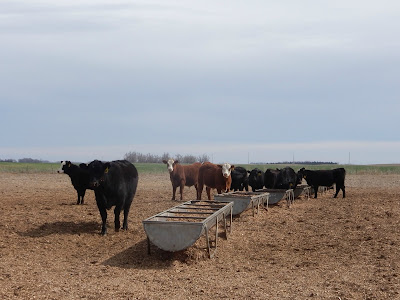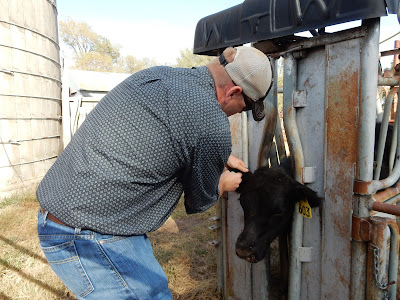Sock sorting is probably no one's favorite job. When there are several people in the family, there always seems to be a sock (or 3) without a mate - whether the dust bunnies under the bed "ate" them or the dryer devoured them. But at least the socks stay in one spot while you sort them. Sorting 700-plus-pound moving objects makes sock sorting seem like a vacation. Socks don't try to run you over!
Tuesday afternoon, we gathered the feeder calves so that we could sort the heifers from the steers. We've been feeding them silage and hay since we weaned them from their mothers last fall.
On Thursday, we will sell our feeder calves at the Pratt Livestock sale barn. We'll sell 75 calves and retain 25 heifers. As we began our sorting adventure, some of the calves were up in the lot lazing around, and others were out in a nearby pasture where we feed the silage and hay. But that was OK. It was a nice afternoon for a 4-wheeler ride.
Well, it was nice until we had to eat their dust.

We keep running them into smaller corrals to make it easier to sort them.
Randy and I were the sorters. And since they are not stationary socks, Ricky ran the gate, in case one - or more - got past us. Yes, that happened.

The vaccination prevents brucellosis, also known as "bangs." This disease causes abortion or premature calving. The vaccination must be performed by an accredited veterinarian, in compliance with state and national regulations.
 Dr. Harder uses a device to "tattoo" the animal to show it had received the brucellosis vaccination. Then he used green ink to mark the tattoo.
Dr. Harder uses a device to "tattoo" the animal to show it had received the brucellosis vaccination. Then he used green ink to mark the tattoo.

After we got the feeder calves corralled on Tuesday afternoon, Randy and I looked for those bands. It's not always easy to see when the calves are milling around. (And it seems they like to turn their rear ends toward us instead of facing forward!) They also have their winter hair, which sometimes makes it hard to see their orange vaccination band on their hairy ears, especially at a glance.
We sent steers out into another lot, since they will head to the sale barn later this morning. We kept 25 heifers to join the County Line herd. Their sisters will also make the trip to Pratt on a semi this morning.
As long as these 25 ladies keep breeding and having quality calves, they'll likely be County Line residents for 8 to 10 years.
More on the semi loading and the day at the sale barn to come!







Such beautiful animals. Is it normal or abnormal dry for you?
ReplyDeleteOur part of the state isn't showing up on the drought monitor yet, but other parts of Kansas are. We definitely need some rain, but, unfortunately, there isn't any in the immediate forecast.
Delete